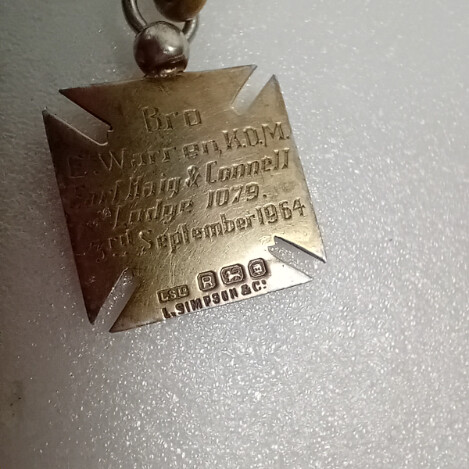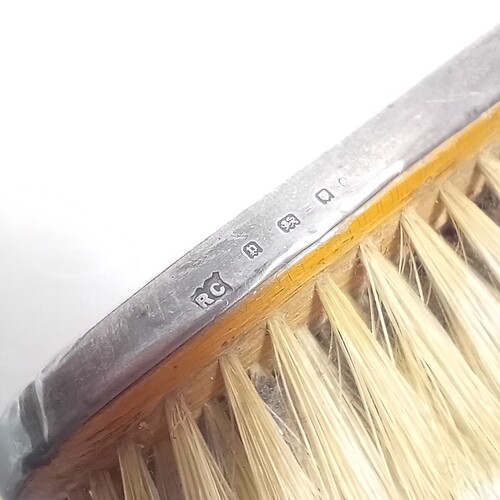Hello. After the amazing help from this forum the other day, would you be so kind and take a look at the following masonic badge? Are they silver hallmarks or plated?

Appears to be sterling, London, 1952.
https://www.silvermakersmarks.co.uk/Dates/London/Cycle%201936-1955.html
And correct for Louis Simpson Ltd:
https://www.silvermakersmarks.co.uk/Makers/London-LR-LZ.html#LS
The listing for Simpson even mentions Masonic badges - probably made them up in bulk!
Oh thank you so much for your really quick reply!
If i post another photo, could you find out these hallmarks please? Its a clothes brush with a silver band around the tortoiseshell top. Its really interesting finding all this information!
Thank you so much!!
You really don’t have to wait for someone else to look these up for you. The information is all online, in a very easy-to-use format. Start by figuring out which assay office it is, then zero in on the date letter.
In this case, it’s London, 1930:
https://www.silvermakersmarks.co.uk/Dates/London/Date%20Letters%20P.html
And the maker is William Comyns & Sons (this son is Richard, hence the “R”):
https://www.silvermakersmarks.co.uk/Makers/London-RA-RD.html#RC
Yes…you’re right,I should do this myself but I’m not very confident about silver and hallmarks, hence why I posted here. I will have a look at the site you have linked…but again, thank you Jeff☺️
Good. Not being confident about what you are discovering is absolutely vital to more learning. It’s also called having an open mind!
The modern ability to post updated information online is a great boon to the modern silver searcher.
But start with the basics. And that means having some sort of grasp of general economic history and how it impacts on the lives and workshops of the smiths of any particular time period.
You will quickly start to spot trends, like in times when new mines are being discovered there is plenty of raw material and silver gets heavier. Other times, especially if there is fighting and a need to pay soldiers (armies are always paid in silver until very recently — taking the King’s Shilling is not just an expression) the silver plate gets thin and domestic items get scarce.
During your English civil war for instance it became a felony to not melt down family silver, so we lost thousands of pieces of Tudor and earlier domestic silver to the blast furnaces at the five royal mints at the time.
Where silver was located usually dictated where kings and queens went. So, for instance, when Charles I lost the Battle of Worcester,and caused the un-necessary deaths of hundreds of Scots who supported him, he was out of soldiers and out of cash.
So he headed up to Shropshire. And it wasn’t because of the great weather, or even the Catholic families then there and still hanging in despite the annual Guy Fawkes burning of them in effigy, it was the mint at Shrewsbury and rumors of hidden hoards of silver.
The Shrewsbury mint, he discovered, was out of silver and the title to Rudge Hall still bears a exemption for buried treasure. Charles had to spend his time shinning up oak trees rather than digging up gold and silver which probably was never there in the first place.
So if you can, go to your local museum or the national repositories in London and elsewhere and just look at the stuff. If you are nice to the staff and don’t look like you might scarper with the loot they will open cases and you can feel weight and shape.
Do that enough and marks, per se, merely confirm what your hands and eyes have told you.
Oh and one final thing about marks, don’t trust in them absolutely. I have friends in China, I won’t say where, who can reproduce silver that can puzzle even the experts. It shows up on ebay from time to time. When it does, folks interested in protecting the integrity of marks gently urge them to delist and they usually do, but we cannot spot everything. For decades after the Americans defeated the Cornwallis and the rest of the British Army they reproduced faux silver marks on New York and Boston items. Today it’s easy to spot but back then it gulled a lot of buyers.
Have fun!
Christopher Wilson
Guildhall Antiques
Grand Cayman and Toronto
Christopher, thank you for your very informative post…I didnt know that about English silver and the Royal families following the loot per se!
I think I have the bug now…ha ha! Lots of reading and it is wonderful having resources (such as this forum)… even to read through old posts etc, Im learning so much but handling item is probably the best way to learn more.
Thank you again and have a great day!
Kings and Queens are generally absolute rulers and they need an army to keep them in power. Soldiers are always paid in silver. Being a cynical lot they rarely take paper money and when offered it, as they were by the French King under the banking tutelage of Robert Law a canny Scotsman, they tend to back off. You may recall both King Louis and that silly Austrian women he married were given an emergency head-ectomy in the public square. Paper money, don’t trust it.
The king who grabbed the largest amount of silver ever was Alexander of Greece – he is called Alexander the Great although what was so great about him is unclear . He stole the entire treasury of the Persians and financed most of the temples and carvings of Ancient Greece including the marbles that your Lord Elgin stole and you, the Brits, still haven’t returned.
Of course sooner or later all this construction was going to run him into difficulties and his silver supply ran out which enabled the Romans, who had captured and were exploiting the Spanish silver mines to pay for a bigger army, to knock the Greeks off their empire.
I could go on, tracing an entire history of the modern world tied to access to silver to pay soldiers but you get the idea.
I have interests in a small town just north of Toronto where the streets are literally paved with silver and which financed 10% of The Great War – although like Alexander I am not sure what was so great about it.
Today the town is coming back to life to provide the eponymous Cobalt needed for batteries. Silver is a waste product of that effort and shipped off to the Ottawa Mint which is starting to print coins with your King’s mug on them. I only met him once out hunting in your country and he seemed pleasant enough but why we have decided he should be our king as well as yours is difficult to explain in this now largely non Northern European country.
CRWW
